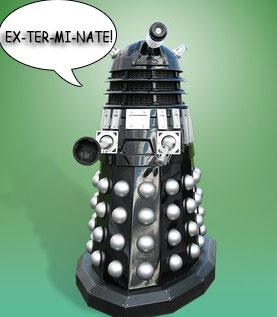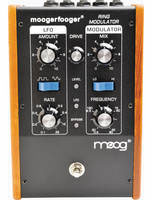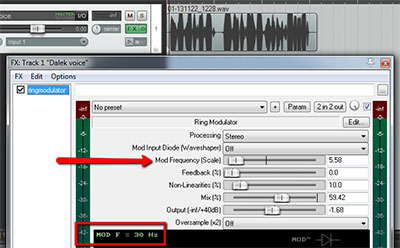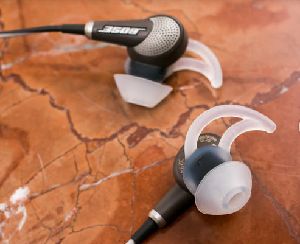 There are some great deals on pro audio gear starting today – Black Friday (November 29th, 2013) through Cyber Monday (December 2nd,) at B&H Photo-Video-Audio.
There are some great deals on pro audio gear starting today – Black Friday (November 29th, 2013) through Cyber Monday (December 2nd,) at B&H Photo-Video-Audio.
So for the next 4 days you can finally order that piece of gear you’ve been hemming and hawing about (do people still say that?). Anyway, it’s a great time to get yourself that mic or interface you’ve been meaning to buy.
CLICK HERE to see all the Black Friday/Cyber Monday deals in the Pro Audio category at B&H.
Archives for November 2013
The Doctor Who Dalek Voice
 [This was originally posted during the week of Dr. Who celebrations around the 50th anniversary in 2013]. History celebrated the 50th anniversary of Doctor Who, and BBC America filled the week with all kinds of specials, premieres, a biopic, and marathons, to culminate in The Day of The Doctor special (the geek in me was all “a-squee” this week:)).
[This was originally posted during the week of Dr. Who celebrations around the 50th anniversary in 2013]. History celebrated the 50th anniversary of Doctor Who, and BBC America filled the week with all kinds of specials, premieres, a biopic, and marathons, to culminate in The Day of The Doctor special (the geek in me was all “a-squee” this week:)).
So what does this have to do with audio? Well if you’re a fan of Doctor Who, you’re probably aware of its most famous villain – the Daleks. These biological alien mutants living inside a tank-like mechanical shell. And they have a very distinctive voice, usually shouting “exterminate! exterminate!” Yeah, they have anger issues. But I digress. What about the audio? It’s that Dalek voice. How do they make it sound like that?
The actor who does the voice of the Daleks (they all sound pretty much the same) – currently Nicholas Briggs – speaks into a microphone hooked up to something called a “ring modulator.” Specifically, he uses a Moog Moogerfooger MF-102 Ring Modulator. They don’t simply process a voice-actor’s audio after-the-fact. Nicholas Briggs is actually on the set and in rehearsals with his audio rig so the other actors can actually hear the real Dalek voice while filming scenes. But what is a ring modulator?
Ring Modulator
A ring modulator is basically a box that mangles audio. Of course, there are plenty of ring modulator software programs – usually in the form of plugins for recording software – that can provide the same effect. If you really want to get into the reasons why it is called a “ring modulator,” and you geek out when you hear the terms “diode circuit” or “bridge rectifier,” you can read all about that here.
But the basics beyond “box that mangles audio” can be explained fairly clearly – in keeping with our mission to present needlessly or overly complex material so anyone can get it. A ring modulator combines two sounds in order to create that mangled audio I mentioned. So let’s start with a single sound, one audio signal. It could be anything – a voice, a drum, a pure tone sine wave, etc.
For the sake of keeping the explanation simple, lets say our sound (the first of the two) is a pure sine wave at a frequency of 440 Hz. That would be an A note, musically – that’s where the term “A440” comes from. If you “modulate” the frequency (which just means to change the frequency) to 880 Hz, you’d get an A note that is the next octave up (if you double the frequency of a note, you get that same note an octave higher). This effect doesn’t simply change octaves like that – there are a more complex things happening with the frequencies. But it’s sort of based on the same idea.
So a ring modulator combines the frequencies of two audio signals together and plays the result. But it also subtracts one frequency from the other. Then it outputs the blended result of both. Wacky, right?
In case you want a bit more information about all he stuff under the hood of ring modulation, check out the wikipedia article here: https://en.wikipedia.org/wiki/Ring_modulation.
The point is that ring modulation is the effect used to create the Dalek voice. Of course you can turn the knobs to change all sorts of parameters on the effect controls, like the frequencies and shape of the audio wave form for extra gnarly sound. But what you probably just want to know is how to make yourself sound like a Dalek, don’t you? Admit it. Yes you do.
How To Make Yourself Sound Like a Dalek

You COULD do it like Nicholas Briggs, and walk around talking into a microphone and carrying your Moogerfooger, microphone, and speaker with you. It would be fun to walk into a restaurant and order your food like a Dalek. Tell them to bring it quickly or they will be exterminated;). But though hilarious, that could be difficult and a bit pricey. The Moogerfooger goes for $289.
Here is how you do it much more affordably (or free, if you already have Reaper recording software).
Open a track in Reaper. Then click the “FX” button on the track control panel and find the effect called: “JS: Liteon/ringmodulator.” It comes with Reaper!
 Next, you will want to make one adjustment to the ring modulator. The first slider is called Mod Frequency (scale). Slide that to the left until it’s at about 5.58. See picture on the left. What you’re going for here is a modulation frequency of 30 Hz. The slider changes that number, which you can see in the black box at the bottom of the plugin (again, see the pic on the left).
Next, you will want to make one adjustment to the ring modulator. The first slider is called Mod Frequency (scale). Slide that to the left until it’s at about 5.58. See picture on the left. What you’re going for here is a modulation frequency of 30 Hz. The slider changes that number, which you can see in the black box at the bottom of the plugin (again, see the pic on the left).Once that’s all set, you can close the FX window and record your voice.
Normally, I would STRONGLY advise against clipping your audio – which is what happens when your voice is too loud for the interface. You get distorted audio. But in this case, that’s what we want! In the picture, you can see (above the plugin window) my voice is all squared off on the top and bottom. That means it’s been clipped. So turn up your interface/input gain, and get your mouth right up against the grill of the microphone. Dynamic mics (like the Shure SM58) work best for this since they are rugged stage mics and are used to being dropped, kicked and screamed into. If you use a condenser mic, be careful not to damage it. They are quite sensitive.
Anyway, get your mouth up to the mic and record yourself reciting some classic Dalek lines, ending of course with the word “EXTER…MI…NATE!” Try to sound as much like a Dalek as you can, with the halting robotic rhythm and the tone rising at the end of each line. Of course you’ll also have to do it in an English accent, since everyone knows that Daleks are all English – specifically they seem to be from the London area by the sound of it;). When you play it back, you will sound like a Dalek.
Below is what it sounded like when I attempted to do all of this. No laughing – this is serious business:).
Audio Player
Good luck, and I hope you enjoyed the 50th Anniversary festivities!

In-Ear Noise-Canceling Headphones – Bose QC20
 The Bose QuietComfort 20 and 20i (QC20/QC20i) is an in-ear headphone (or I guess you can call them earphones, like we had when I was a kid in the 70s) that by all accounts is the best noise-canceling headphones available that are not big cups that hang off the side of your head.
The Bose QuietComfort 20 and 20i (QC20/QC20i) is an in-ear headphone (or I guess you can call them earphones, like we had when I was a kid in the 70s) that by all accounts is the best noise-canceling headphones available that are not big cups that hang off the side of your head.
I said “by all accounts” because the reviews by the likes of CNET and Forbes have anointed the QC20 the clear winner in the category of noise-cancellation by from, basically, earbuds.
It has become common with people who travel a lot, especially on planes, to block out distracting and irritating noise. The tool of choice for this has become noise-canceling headphones. Typically you have only been able to get this from traditional type headphones, either the kind that go on your ears, or the kind that go over them, fully encompassing your ears and resting on your noggin. That last variety is called “circumaural” or just full size headphones.
Circumaural headphones have the advantage, right off the bat, of being able to block out noise simply because they seal around your ears. This is called passive noise reduction. Then if you add active noise cancellation – electronically preventing certain frequencies from being audible (by means of mirroring incoming sound and creating a negative of it) – and it becomes pretty clear that you can get the most noise reduction from circumaural headphones. That’s why you see so many people on airplanes these days looking like they just came off a firing range. They’re bulky and unwieldy.
So wouldn’t it be great if you could get similar noise-blocking from something a lot more convenient like earbuds? They can provide some passive noise cancellation by physically blocking your ear canal. But if you add in the active noise cancellation too, you can have a much lower profile, lighter, and more convenient experience while traveling.
Of course there are several brands of in-ear noise-cancelling headphones out there. But the Bose QuietComfort 20 and 20i (the 20i being the one specifically designed for Apple iPods, iPhones and iPads) has been dubbed the best of these in several on-line reviews, including this one from CNET – Bose QuietComfort 20 review.
Of course, as with most modern noise-canceling headphones, the QC20s are equipped with in-line mic/remote for Android, Blackberry, and Windows phones. And the QC20i works with iPhones.
So if you are looking for a quiet traveling experience, but don’t want to deal with big, bulky headphones, the best quality you can get comes in the form of the Bose QC20. CLICK HERE for more information or to buy.
What Microphone Was Austin Mahone Using In McDonalds Commercial?
 Wondering what kind of microphone Austin Mahone is using in that MacDonalds ad? On the latest TV commercial for McDonald’s, Austin Mahone is in a recording studio singing into a very interesting looking microphone. It’s called The Bottle, by Blue Microphones. It’s a large diaphragm tube condenser microphone, and is Blue’s flagship mic. Not only does it have the incredible sound of a high quality tube condenser mic, but it has interchangeable capsules, called “bottle caps.” These different capsules, seven in all, offer different types of sound by providing different frequency and sensitivity responses, as well as a variety of pick-up patterns.
Wondering what kind of microphone Austin Mahone is using in that MacDonalds ad? On the latest TV commercial for McDonald’s, Austin Mahone is in a recording studio singing into a very interesting looking microphone. It’s called The Bottle, by Blue Microphones. It’s a large diaphragm tube condenser microphone, and is Blue’s flagship mic. Not only does it have the incredible sound of a high quality tube condenser mic, but it has interchangeable capsules, called “bottle caps.” These different capsules, seven in all, offer different types of sound by providing different frequency and sensitivity responses, as well as a variety of pick-up patterns.
If you’d like more information on the Blue Bottle mic, or even to buy your very own, CLICK HERE. Since this mic is a very high-end piece of gear, and could be outside your budget at just under 6 grand, you might want to have a look at their entire line of microphones, which include excellent mics at all price levels starting at under $100, HERE.